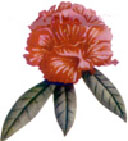 National Color
Crimson (Simrik in Nepali), the national colour is considered very auspicious and has a significant place in Nepal's cultural life. It also has a symbolic connotation for Hindus, signifying good luck and fortune.
National Color
Crimson (Simrik in Nepali), the national colour is considered very auspicious and has a significant place in Nepal's cultural life. It also has a symbolic connotation for Hindus, signifying good luck and fortune.

The National Flag of Nepal is unique in that it is the only national flag in the world not rectangular in shape. This distinctive flag consists of two juxtaposed triangular figures with a crimson base and deep blue borders. The upper part has a white emblem of the crescent moon with eight rays, while the lower one bears a twelve-rayed white emblem of the sun. .
 Lali Gurash
Lali Gurash
The Rhododendron Arboreum (Lali Gurash in Nepali) is the most famous and attractive amongst over 30 species of rhododendrons found in the hills of Nepal. The tallest of its trees attains heights of up to 15metres. The Lali Gurans, with its beautiful bell-shaped flowers, is widely distributed Throughout the whole length of Nepal from 4,000 ft to 12,000 ft of the sea-level. Its blossoming heralds the advent of spring.
 Royal Standard
Square in shape and crimson in color, the Royal standard is traditionally comprised of a crescent moon, in the upper corner near the flagstaff with eight of sixteen rays shown in white color, and a white sun with twelve white rays in the upper corner opposite to the flagstaff, and a white flag showing a six-angled figure and a sword in the middle of the standard with an upright white lion facing the flag with both its paws holding, and the right hind leg supporting, the flagstaff.
Royal Standard
Square in shape and crimson in color, the Royal standard is traditionally comprised of a crescent moon, in the upper corner near the flagstaff with eight of sixteen rays shown in white color, and a white sun with twelve white rays in the upper corner opposite to the flagstaff, and a white flag showing a six-angled figure and a sword in the middle of the standard with an upright white lion facing the flag with both its paws holding, and the right hind leg supporting, the flagstaff.
 National Color
Crimson (Simrik in Nepali), the national colour is considered very auspicious and has a significant place in Nepal's cultural life. It also has a symbolic connotation for Hindus, signifying good luck and fortune.
National Color
Crimson (Simrik in Nepali), the national colour is considered very auspicious and has a significant place in Nepal's cultural life. It also has a symbolic connotation for Hindus, signifying good luck and fortune.
National Animal The cow, Nepal's national animal, is highly revered by Hindus all over the world. Hindu mythology refers to the cow as 'gau mata', giving her a human face of a mother. It is in this light that the Nepalese worship the cow.
National bird Nepal's national bird, the lophophorus (Danphe in Nepali) is one of the most beautiful birds found in the kingdom. Listed as an endangered species, this most exotic of all pheasants inhabits high elevations of the Himalayan range. In Hindu mythological accounts, it is described as a guide to Lord Mahadev (Lord Shiva), who dwelled in the Himalayas.